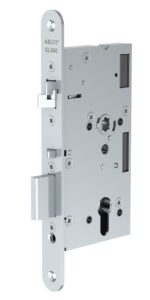When it comes to access control in public buildings, specifying the right locking solutions for emergency escape and fire doors is a critical responsibility.
In 2018, England recorded 177,844 fires, marking a 5% rise from the previous year. This figure is alarmingly high, emphasising the need for fire doors and emergency escape doors to be compliant and regularly inspected to prevent further injuries and fatalities.
### Who Holds the Responsibility?
Those responsible for public buildings—whether employers, building owners, or facilities managers—carry both a moral and legal duty to ensure that access control systems meet current regulations. The Regulatory Reform (Fire Safety) Order 2005, often referred to as the Fire Safety Order (FSO), places the responsibility for fire safety on those who have day-to-day control of the premises.
Despite these regulations, awareness regarding fire safety responsibilities remains low. There is an urgent need for better education on fire door safety and the importance of specifying compliant solutions. This knowledge is essential not only for the safety of occupants but also to protect building managers from liability in case of an incident.

### Establishing Standards
Several building regulation standards relate to access control, and adherence to these standards is vital for ensuring safety and security. Key standards include EN179 (Emergency Escape for aware occupants), EN1125 (Panic Escape for public environments), and the new EN13637 (Electronically Controlled Escape Systems for escape routes).
These standards stipulate that even electronically controlled doors must have a compliant mechanical escape mechanism in emergencies. For fire doors, this is crucial for providing fire protection, compartmentalising the building, and safeguarding escape routes. This function is also vital in terror situations, allowing for the isolation of certain areas while ensuring safe exit routes for the public.

### Ensuring Compliance
In emergencies like fires, reliable exit routes are essential for quick escapes, making the choice of locking solutions at access points critical. Electric locking systems—such as motorised or solenoid locks—offer significant safety advantages over door magnets.
Magnetic locks can pose fire risks, as they require specific setups to ensure they remain fail-safe in emergencies. Some magnetic systems necessitate an alarm or ‘request to exit’ feature, potentially causing life-threatening delays during critical moments.

Electric locks are also more energy-efficient; for instance, 13 door magnets consume as much electricity as continuously boiling a kettle, while electric locks use only about 10-20% of that energy for the same period.
### Abloy’s Compliance Solutions
Abloy UK provides a range of compliant security solutions tailored for panic and escape doors. Its selection of electric locks, including motor and solenoid locks, meets mandatory fire and escape standards.
Solenoid locks, like the Abloy EL560, are designed for internal doors in public buildings, offices, schools, and hospitals, as well as external doors for residences. Motorized locks, such as the Abloy EL520, operate by retracting the bolt when a proximity card or device is presented. Both types automatically secure a deadbolt upon closing and can be integrated with appropriate escape mechanisms based on the environment.

### Balancing Safety and Security
Access control is often described as managing the flow of legitimate individuals, while security focuses on preventing unauthorised access. Too frequently, these objectives conflict, leading to compromises in both safety and security.
With the introduction of the Construction Product Directive and EN 13637 for Electrically Controlled Emergency Escape Doors, a comprehensive set of escape standards is now available. Recent years have underscored the critical importance of compliance in access control systems for emergency escape and fire doors. Adhering to the latest regulations could truly save lives.


